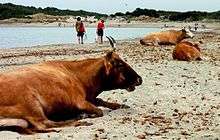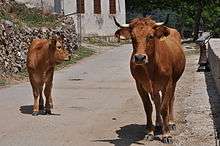Corsican cattle
Corsican Cattle or Corsicana is a French cattle breed.

Origin

Corsican Cattle is the only native cattle to the island of Corsica. There is no breed registry and therefore is not considered a breed in a narrow sense but rather a population. There is no collective program of genetic selection. Studies have shown that its isolation for millennia helped to form a stable homogeneous population. In 2001 there were 28,000 cows and 1,300 bulls for natural and 6 for artificial insemination. The numbers are stable and 60% of females reproduce purebred.
Morphology
The breed has a tan coat with shades ranging from blond to dark wheat and gray. The belly is often lighter. The mucous membranes are dark. The lyre-shaped horns are brought up. The breed is of small size and low weight. Cows measures 1.15 m and 280 kg, the bulls 1.20 and 350 kg.
Use

Today the breed is primarily for meat production. Formerly it was also used for traction, but its small size limited its capacity. It is not used for cheese because the Corsican cheese tradition was based on sheep and goat. Therefore, milk production is low but enough to raise a calf.
- Good resistance to heat,
- Good ability to transform a poor diet
- Good ability to replenish body reserves after times of scarcity (summer drough )
- Easy calving (it only calves outdoors),
- Excellent maternal qualities
Currently two separate farming methods are practiced: In the mountains it is pure breed in areas where it is the only one to be profitable. There is an extensive farming with the animals almost ranging free. This farm provides weanlings, young beef bulls and heifers for breeding. In the more favorable zone there are herds of female Corsican cows crossed with bulls of beef breeds like Limousin, Aubrac or Charolais.
See also
Links
- Race bovine CORSE (French)